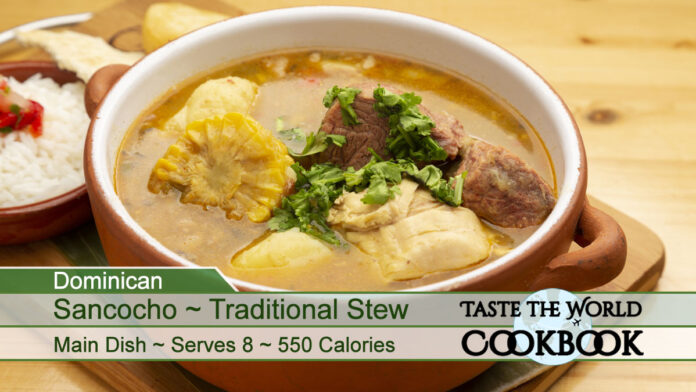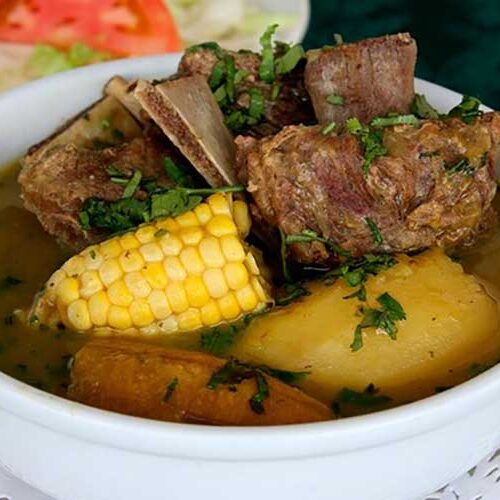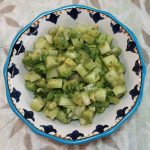Embarking on a culinary adventure, we find ourselves in the bustling streets of Santo Domingo, where the aroma of Sancocho fills the air. This rich and hearty stew, a symbol of Dominican hospitality, invites friends and family to gather around the table. But Sancocho is more than just a delicious meal; it’s a reflection of the Dominican Republic’s diverse culture and history.
In this exploration, we’ll not only dive into the bubbling pot of Sancocho itself, uncovering its ingredients and various ways to make it, but also venture into its storied past. Next, we’ll take a virtual stroll through Santo Domingo, unveiling its culinary scene, tourist attractions, and hidden gems. Finally, whether you’re a seasoned cook or a curious food enthusiast, our detailed recipe will guide you step by step to bring the warmth of Sancocho into your own kitchen.
So, grab your apron and your passport, and join us on this delectable journey!
Table of contents
- Sancocho, Many Ways: A Stew with a Thousand Faces
- Santo Domingo: The Heartbeat of the Caribbean, Where Tradition Meets Modernity
- Sancocho Symphony: Crafting the Dominican Republic’s Soul-Warming Stew
- A Culinary Ensemble: Flavorful Companions to Dominican Sancocho
- A Taste of Santo Domingo: Your Invitation to Explore and Share
Sancocho, Many Ways: A Stew with a Thousand Faces
Sancocho is a dish that lends itself to creativity and personal touch. Starting with the Dominican Republic, the version we are focusing on, a rich blend of meats, root vegetables, and hearty broth captures the essence of the island’s culinary tradition. However, this is only one face of Sancocho’s multifaceted personality.
Moving westward to Puerto Rico, Sancocho takes on a distinct character. Here, it often features a combination of beef and chicken, accompanied by a sofrito base, which adds a unique flavor. Corn on the cob and small dough balls known as “bolas de plátano” bring texture to this variation.
Venturing into Colombia, Sancocho reveals yet another dimension. In the Andean region, you might find Sancocho de Gallina, a chicken-based stew slow-cooked with potatoes, yuca, and local herbs. Meanwhile, along the coastal areas, fish becomes the star of the dish, reflecting the maritime culture.
Next, let’s explore the Venezuelan twist. Sancocho de Pescado, a fisherman’s stew, combines fresh catch with lime, cilantro, and a hint of chili, creating a zestier flavor profile that’s truly invigorating.
Finally, Panama presents a blend of cultural influences, featuring Sancocho de Gallina Panameño, a chicken stew often considered the national dish. Utilizing unique local ingredients like “ñame,” a type of yam, Panamanian Sancocho stands as a testament to the region’s rich agricultural heritage.
In conclusion, Sancocho is not confined to a single recipe or region. From country to country, and even from home to home, this beloved stew transforms, adapts, and evolves. Each version tells a story, reflects a culture, and invites you to explore, taste, and savor. Whether you choose to stay true to the Dominican classic or venture into a new variation, Sancocho welcomes you with open arms and a world of flavors.
Sancocho for Tomorrow: Storing the Soul of Dominican Cuisine
Sancocho, with its complex flavors and hearty ingredients, is often made in large batches, leading to delightful leftovers. But how do we preserve the essence of this Dominican stew for future enjoyment? Let’s explore the art of storing Sancocho, ensuring that each reheated bowl tastes as fresh as the first.
- Firstly, allow the Sancocho to cool to room temperature after cooking. Placing a hot stew directly in the refrigerator can lower the overall temperature of the appliance, affecting other stored items.
- Transitioning to storage, transfer the cooled Sancocho into airtight containers. If you’re planning on enjoying it within the next three days, the refrigerator will suffice. Ensure the containers are sealed properly to lock in the flavors and prevent moisture loss.
- For a longer storage period, consider freezing your Sancocho. Divide it into portion-sized containers or resealable freezer bags. By doing so, you can easily thaw only what you need, minimizing waste. Before placing it in the freezer, make sure to label each container with the date, so you can keep track of the freshness.
- When the craving strikes again, reheating Sancocho is a breeze. If frozen, let it thaw in the refrigerator overnight. Then, transfer it to a pot and warm over low heat, stirring occasionally. A splash of water or broth can help rejuvenate the consistency, bringing back the vibrant textures and flavors.
- Lastly, do remember that Sancocho, like many stews, often develops a deeper flavor profile as it rests. The fusion of ingredients continues even in storage, culminating in an even more delightful culinary experience the next day.
In essence, storing Sancocho is not merely a practical matter; it’s a continuation of the culinary journey. By following these simple steps, you can savor the joy of Sancocho not just once but over several satisfying meals. So go ahead, cook a big pot, and rest easy knowing that the soul of Dominican cuisine is safely tucked away for another day.
Sancocho Through Time: A Stew of Cultures and Continents
Sancocho is not merely a dish; it’s a historical tapestry woven from various culinary traditions and cultural influences. Let’s take a culinary time machine and trace the origins and evolution of this beloved Latin American stew.
Starting with the roots, Sancocho’s foundation lies in the indigenous cultures of Latin America. Utilizing locally available root vegetables and meats, the native people created hearty stews to nourish their communities. The very word “Sancocho” stems from the Spanish verb “sancochar,” meaning to parboil, reflecting the cooking technique at its core.
With the arrival of the Spanish conquerors, new ingredients, flavors, and culinary techniques merged with indigenous practices. The introduction of European meats and spices transformed the local stews, giving birth to what we now recognize as Sancocho.
Moving forward in time, the African influence added another layer to Sancocho’s rich identity. Slaves brought to the Caribbean and Latin America introduced new cooking methods and ingredients, such as plantains, further shaping the dish’s character.
As we travel from country to country, we notice how Sancocho takes on unique variations. From the fish-based Sancocho of coastal regions to the meat-heavy versions in landlocked areas, each locality adds its distinctive touch. The adaptability of Sancocho mirrors the diversity of the landscapes and people, making it a symbol of regional pride.
In the modern era, Sancocho continues to evolve, reflecting contemporary tastes and global influences. Fusion versions are appearing in upscale restaurants, while home cooks experiment with vegetarian and vegan alternatives.
In conclusion, the history of Sancocho is a flavorful journey through time, geography, and culture. It tells a story of resilience, adaptability, and unity, as diverse ingredients come together in a harmonious blend. Each bowl of Sancocho is not just a satisfying meal but a celebration of a shared heritage that continues to nourish the soul of a continent. Whether enjoying it in the bustling streets of Santo Domingo or in the comfort of your own home, Sancocho connects us to a rich and flavorful past that continues to simmer in the present.
Santo Domingo: The Heartbeat of the Caribbean, Where Tradition Meets Modernity
Santo Domingo, the capital city of the Dominican Republic, is more than a bustling metropolis. It’s a fascinating blend of history, culture, modernity, and tropical charm. Let’s embark on a virtual tour of this vibrant city, where the echoes of the past meet the pulse of the present.
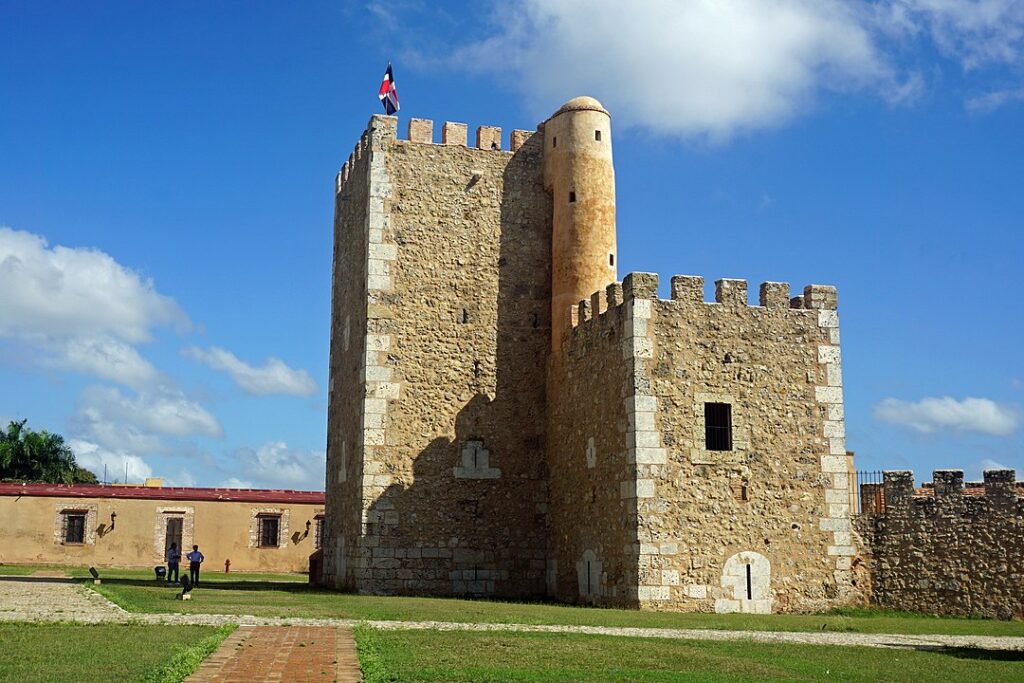



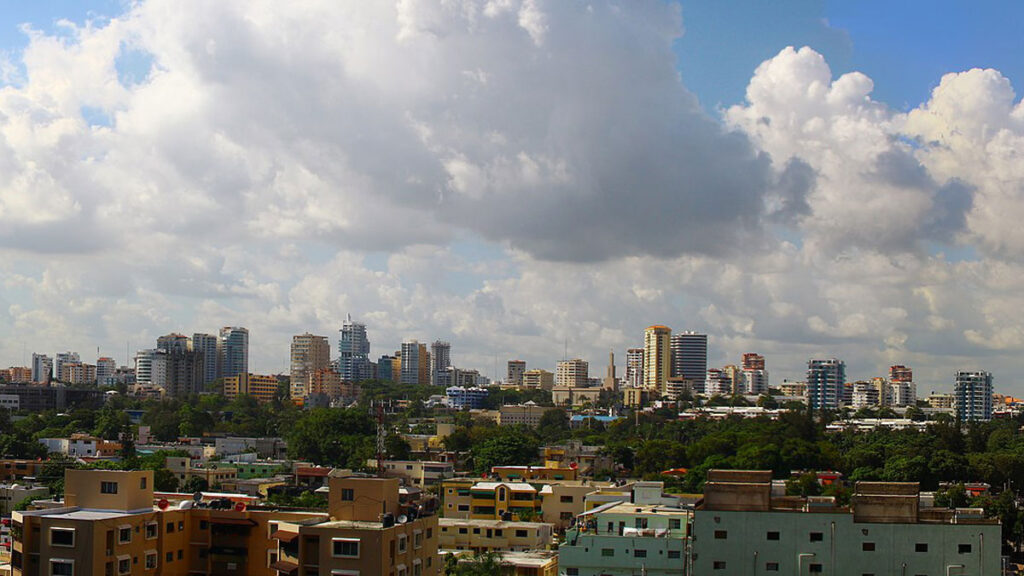
Starting with the historical core, Santo Domingo’s Colonial Zone (Zona Colonial) is a living testament to the city’s rich history. Walking along the cobblestone streets, you’ll find the first cathedral, university, and hospital of the Americas. Each building narrates a story, reflecting the complex fusion of Spanish, African, and Taino influences.
Transitioning into the modern era, Santo Domingo’s skyline showcases an impressive array of contemporary architecture. Towering skyscrapers, luxurious shopping malls, and innovative art galleries stand in contrast to the colonial relics, symbolizing the city’s dynamic growth.
Exploring the culinary scene, Santo Domingo’s diverse food culture offers something for every palate. From street vendors serving traditional Dominican fare to upscale restaurants showcasing international cuisines, food becomes a window into the city’s multicultural identity.
Venturing into the neighborhoods, each district of Santo Domingo reveals a unique character. From the upscale Piantini with its chic boutiques to the artsy Gazcue filled with galleries and theaters, the city invites exploration and discovery.
Engaging with the people, Santo Domingo’s true strength lies in its residents. The warmth, hospitality, and vibrant energy of the locals breathe life into the city. Whether dancing to merengue on a street corner or engaging in passionate conversations in a local café, the people make Santo Domingo a place of connection and joy.
Finally, embracing the natural beauty, Santo Domingo’s coastal location offers stunning sea views and tropical escapes. The nearby beaches provide a tranquil respite from the city’s hustle, while lush parks offer green oases in the urban landscape.
In conclusion, Santo Domingo is not just a city; it’s a sensory experience that weaves together history, culture, modernity, and natural beauty. It’s a place where Sancocho simmers in traditional kitchens, and new ideas brew in innovative minds. From the ancient walls of the Colonial Zone to the modern beat of urban life, Santo Domingo stands as a proud testament to the Dominican spirit, ever-evolving yet firmly rooted in its rich heritage.
Santo Domingo Uncovered: A Tourist’s Treasure Map to the Dominican Gem
Santo Domingo, the capital city of the Dominican Republic, is a mosaic of experiences waiting to be explored. From historical landmarks to natural wonders, this city offers a myriad of attractions for every type of traveler. Let’s dive into the diverse world of tourism in Santo Domingo, uncovering the treasures that await.
First and foremost, history enthusiasts will find a goldmine in the Zona Colonial. Designated a UNESCO World Heritage Site, this area houses centuries-old buildings, churches, and forts. Wandering through its charming streets, you can’t help but feel transported back in time, absorbing the rich stories that shaped the New World.
Next, for the nature lovers, Santo Domingo provides a refreshing escape with its lush gardens and stunning coastlines. The National Botanical Garden offers a tranquil oasis in the midst of the city, while a short drive leads you to pristine beaches where the Caribbean Sea caresses the golden sands.
Transitioning to the urban scene, art and culture aficionados will delight in the city’s thriving arts community. Galleries, theaters, and museums showcase both classical and contemporary works. Don’t miss the Museum of Modern Art for a peek into the innovative spirit of Dominican artists.
For the foodies, Santo Domingo serves a culinary adventure, blending traditional Dominican flavors with international influences. Whether indulging in a bowl of Sancocho at a local eatery or savoring gourmet seafood with an ocean view, the city’s gastronomic landscape is a feast for the senses.
Venturing into the nightlife, Santo Domingo pulses with energy as the sun sets. Dance the night away in a salsa club, enjoy live music at a beachside bar, or simply stroll along the illuminated Malecón, embracing the city’s vibrant rhythm.
Shopping enthusiasts, fear not! Santo Domingo boasts a wide array of shopping experiences, from bustling markets selling local crafts to chic boutiques offering high-end fashion. The Mercado Modelo is a must-visit for unique souvenirs and a taste of local life.
Lastly, for those seeking relaxation, luxury resorts and wellness spas provide a serene escape, offering rejuvenating treatments infused with Caribbean flair.
In conclusion, Santo Domingo is more than a destination; it’s a journey through a rich tapestry of experiences. Whether you’re a history buff, a nature lover, a food enthusiast, or simply a wanderer seeking new horizons, Santo Domingo extends an invitation, promising memories that will linger long after the trip concludes. Come uncover the treasures of this Caribbean gem, and let Santo Domingo leave an indelible mark on your traveler’s heart.
Rest & Relaxation in Santo Domingo: A Guide to Comfort from Hostels to Luxury Resorts
Finding the perfect place to stay in Santo Domingo is like selecting the right seasoning for a dish: it can elevate the entire experience. Whether you’re a backpacker seeking a budget-friendly hostel or a luxury traveler desiring a five-star resort, Santo Domingo has the perfect accommodation to suit your needs. Let’s explore the options, ensuring your stay in this vibrant city is as comfortable as it is memorable.
Firstly, for the budget-conscious travelers, Santo Domingo offers a variety of hostels and guesthouses. These options provide a communal atmosphere, allowing you to meet fellow travelers and often enjoy shared amenities like kitchens and lounges. Don’t overlook the local “bed and breakfast” establishments, where Dominican hospitality shines.
Transitioning to mid-range options, boutique hotels and family-run inns offer a delightful balance of comfort and affordability. With personalized service, unique decor, and often central locations, these accommodations provide an authentic and cozy base for your Santo Domingo adventures.
For those seeking luxury, Santo Domingo’s upscale resorts and hotels are a world of indulgence. Imagine sipping a tropical cocktail by a pristine pool, indulging in spa treatments infused with Caribbean essences, or dining in gourmet restaurants with ocean views. From private villas to internationally recognized hotel chains, opulence awaits.
Next, consider vacation rentals and apartments, especially for longer stays or larger groups. These accommodations offer a home-away-from-home experience, complete with kitchens, laundry facilities, and often added privacy. Platforms like Airbnb connect you directly to local hosts, enhancing the personal touch of your stay.
Exploring unique options, you may stumble upon historic colonial homes converted into lodgings, eco-friendly retreats, or beachside bungalows. These accommodations offer something out of the ordinary and can make your stay truly special.
Finally, for the business travelers, Santo Domingo provides a range of modern hotels equipped with business centers, meeting rooms, and high-speed internet. Positioned near commercial districts and offering efficient services, these establishments ensure a productive and hassle-free business trip.
In conclusion, the array of accommodations in Santo Domingo is as diverse and colorful as the city itself. Research and book ahead, considering your budget, preferences, and travel style. Whether nestled in a historic neighborhood, overlooking the sparkling Caribbean Sea, or immersed in the lively city center, your perfect Santo Domingo abode awaits. Rest assured, the city’s range of lodging options promises a comforting end to each exciting day, allowing you to wake up refreshed and ready to explore all that Santo Domingo has to offer.
A Culinary Carnival: Exploring the Flavors of Santo Domingo’s Diverse Cuisine
The cuisine of Santo Domingo is a vibrant dance of flavors, textures, and aromas. It reflects the city’s rich cultural tapestry, blending indigenous Taino, Spanish, African, and even Middle Eastern influences into a culinary celebration. From street food to gourmet dining, let’s embark on a gastronomic journey through Santo Domingo’s diverse culinary landscape.
Starting with the staples, no culinary exploration of Santo Domingo is complete without savoring the Dominican Republic’s national dish, “La Bandera.” Comprising rice, red beans, meat, and fried plantains, this comforting meal embodies the soul of Dominican home cooking.
Next on our flavorful journey, street food is a must-try. Embrace the lively local culture by indulging in “chimis” (Dominican burgers), fried yuca, or “empanadas.” Street vendors artfully craft these delights, offering a taste of Santo Domingo’s heart and hustle.
Transitioning to the seafood scene, Santo Domingo’s coastal location blesses it with an abundance of fresh fish and seafood. From grilled lobster to ceviche, coastal eateries serve a taste of the Caribbean Sea, often accompanied by stunning views.
For those with a sweet tooth, the city’s desserts are a carnival of flavors. Try “dulce de leche” or “habichuelas con dulce,” a unique sweet bean dish often enjoyed during Lent. These sweets are not just delicious but steeped in tradition and love.
Exploring the fusion cuisine, Santo Domingo’s chefs are constantly innovating, combining local ingredients with international techniques. Fine dining establishments showcase this creativity, offering a modern twist on traditional dishes.
Venturing into the local markets, you’ll find a colorful display of tropical fruits, vegetables, spices, and more. These markets are a sensory experience and provide insight into the ingredients that form the foundation of Dominican cuisine.
Don’t overlook the beverages, as Santo Domingo offers a variety of traditional drinks to quench your thirst. From refreshing “morir soñando” (a milk and orange juice beverage) to the celebrated Dominican rum, the city’s drinks add a spirited touch to the culinary adventure.
In conclusion, the cuisine of Santo Domingo is a celebration of diversity, tradition, innovation, and above all, flavor. It invites you to sit at the table, share in the joy of food, and connect with the essence of this vibrant city. Whether enjoying a humble bowl of Sancocho or a gourmet fusion dish, the flavors of Santo Domingo are a delightful dance that tantalizes the taste buds and warms the soul. Your culinary exploration of this Dominican gem is more than a meal; it’s a flavorful embrace, an invitation to taste the heart of the Caribbean.
– Featured Restaraunt –
Mesón de Bari
C. Hostos 302, Santo Domingo 10210, Dominican Republic
Telephone: +1 809 689 5546
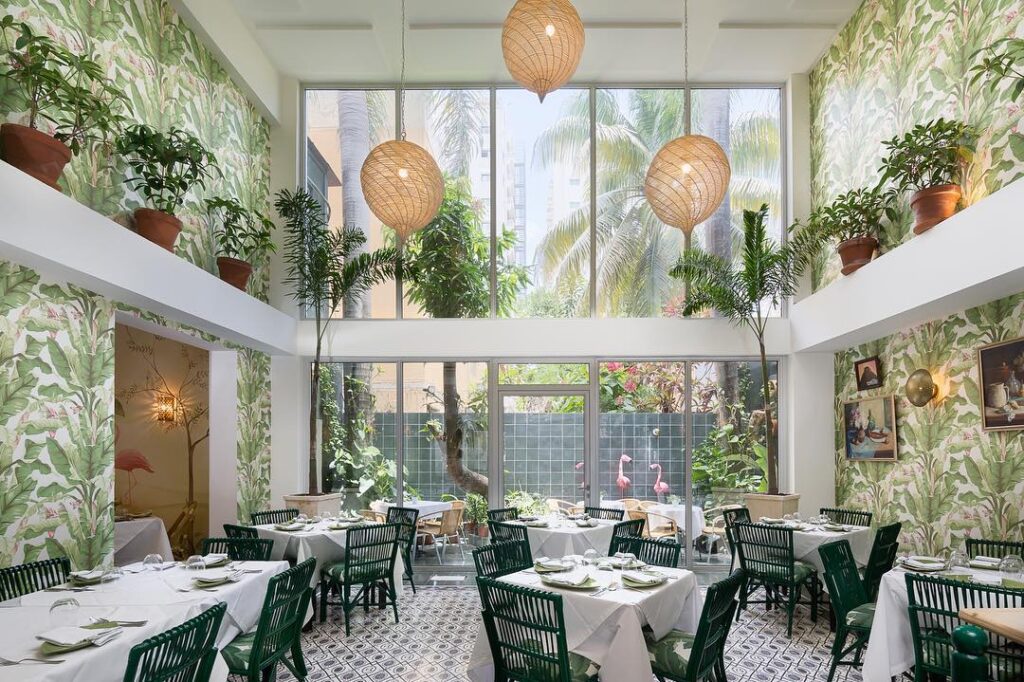
Nestled in the heart of Santo Domingo, Mesón de Bari offers a genuine taste of Dominican culinary heritage. From the moment you step inside, the colorful decor, filled with local artwork, exudes warmth and authenticity, transporting diners to the essence of Caribbean culture.
The menu at Mesón de Bari is a delightful exploration of traditional Dominican flavors. Their Sancocho, served in a bubbling clay pot, is nothing short of a masterpiece. The blend of meats and vegetables stewed to perfection with herbs and spices is a soul-warming experience that resonates with the island’s vibrant character. Pair it with their freshly made “tostones,” and you have a meal that sings to the heart.
Sancocho Symphony: Crafting the Dominican Republic’s Soul-Warming Stew
Sancocho is more than a dish; it’s a culinary embrace that warms the heart and feeds the soul. A rich stew filled with meat, vegetables, and starchy roots, Sancocho is the Dominican Republic’s comfort food par excellence. Let’s journey through the stages of crafting this iconic dish, creating a symphony of flavors that resonates with Santo Domingo’s vibrant spirit.
Starting with the essentials, you’ll need various meats like chicken, pork, and beef, along with starchy vegetables such as yams, plantains, and taro. These core ingredients form the hearty base of Sancocho, representing the dish’s rural roots.
Next, marinating the meats in a blend of garlic, lime, cilantro, and traditional seasoning adds depth and zest to the flavors. Allow the meats to soak in this marinade for at least a few hours, infusing them with the essence of Dominican cuisine.
Now, let’s ignite the stove, heating a generous splash of oil in a large pot. Brown the meats to seal in the juices, creating a flavorful foundation for the stew. This stage is crucial for developing the rich, savory notes that characterize Sancocho.
Transitioning to the vegetables, peel and chop them into hearty chunks. Add them to the pot along with sufficient water or broth to cover the ingredients. Watching them simmer and soften in the bubbling broth is like witnessing a culinary dance, as the flavors begin to meld and harmonize.
For the seasoning symphony, add a generous spoonful of “sazón” or Dominican seasoning mix, along with salt, pepper, and a handful of fresh cilantro. Stir and taste, allowing your senses to guide the seasoning. The aroma filling your kitchen becomes a fragrant reminder of Santo Domingo’s bustling markets and lively eateries.
Finally, the patient simmer. Cover the pot and allow the Sancocho to simmer gently for several hours. This slow cooking process melds the flavors, tenderizes the meats, and transforms the ingredients into a soul-warming stew.
In conclusion, crafting Sancocho is not just cooking; it’s a celebration of Dominican culture and heritage. The process is as rich and engaging as the dish itself, filled with tradition, love, and flavor. As you ladle the steaming Sancocho into bowls, garnished with a sprig of cilantro, you’ll be serving more than a meal. You’ll be sharing a piece of Santo Domingo, a culinary embrace that transcends borders and warms the heart. Whether enjoyed with family on a rainy day or shared with friends at a festive gathering, Sancocho stands as a testament to the Dominican spirit, a symphony of flavors that sings of home.
Gathering the Symphony: Ingredients for the Authentic Dominican Sancocho
rafting Sancocho is akin to composing a musical masterpiece, where each ingredient plays a vital note in a harmonious symphony. Beginning with the meats, the combination of chicken, beef, and pork provides a robust base, each adding its unique texture and flavor. Accompanying these are the starchy vegetables like plantains, yams, and taro, which lend body and heartiness to the stew. These essential ingredients, enriched with herbs, spices, and citrus, come together in a culinary concert that resonates with the Dominican soul.
Transitioning to the seasonings, the spotlight shines on the blend of garlic, lime, cilantro, and traditional “sazón.” These flavor conductors orchestrate the dish’s signature taste, a vibrant fusion that echoes the lively spirit of Santo Domingo. Whether gathered from bustling local markets or sourced from your favorite grocery store, these ingredients are the keys to unlocking an authentic Sancocho experience. Prepare to embrace their harmony, and let’s delve into the recipe to begin our culinary performance!
Equipment Needed
- 1 Dutch Oven
- 1 Cutting Board
- 1 Knife
- 1 Wooden Spoon
- Bowls for marinating and serving
Ingredients Needed
- 1 lb beef cut into chunks
- 1 lb pork cut into chunks
- 1 lb chicken cut into chunks
- 1 lb goat meat optional
- 2 ears corn cut into pieces
- 1 green plantain peeled and sliced
- 1 ripe plantain peeled and sliced
- 1 yam peeled and sliced
- 1 yuca cassava, peeled and sliced
- 2 potatoes peeled and sliced
- 1 taro root peeled and sliced
- 2 large carrots peeled and sliced
- 1 large onion chopped
- 1 bell pepper chopped
- 4 cloves garlic minced
- 2 tbsp cilantro chopped
- 1 lime juiced
- 3 quarts chicken or beef broth
- 3 tbsp vegetable oil
- Salt and pepper to taste
- 2 tsp oregano
- 1 tsp cumin
- salt to taste
- black pepper to taste
- 2 limes juiced
- 3 garlic cloves minced
How to Cook Dominican Sancocho
Time needed: 3 hours and 30 minutes
Cooking Directions for Dominican Sancocho
- Marinate the Meats:
Mix the ingredients for the seasoning mix in a bowl. Coat the meats with the mixture and let marinate for at least 1 hour, preferably overnight.
- Brown the Meats:
In a large pot or Dutch oven, heat the vegetable oil over medium-high heat. Add the meats and brown on all sides. You may need to do this in batches.
- Add Vegetables and Broth:
Add the onion, bell pepper, and garlic to the pot. Cook until softened. Then add the broth, cilantro, and lime juice.
- Simmer:
Bring the pot to a boil, then reduce to a simmer. Cover and cook for 1 hour.
- Add Root Vegetables:
Add the yuca, yam, taro, and corn to the pot. Continue to cook for another 30 minutes.
- Add Remaining Vegetables:
Add the plantains, potatoes, and carrots to the pot. Continue to cook for another 30 minutes, or until all the ingredients are tender.
- Season and Serve:
Season with salt and pepper to taste. Serve hot in bowls with a side of rice and avocado if desired.
If you liked this dish please Rate This Recipe and leave a comment.
Dominican Sancocho Recipe
Please Rate this Recipe
Equipment
- 1 Knife
- Bowls for marinating and serving
Ingredients
Seasoning Mix (Marinade)
- 2 tsp oregano
- 1 tsp cumin
- salt to taste
- black pepper to taste
- 2 limes juiced
Sancocho
- 3 tbsp vegetable oil
- 1 lb beef cut into chunks
- 1 lb pork cut into chunks
- 1 lb chicken cut into chunks
- 1 lb goat meat optional
- 1 large onion chopped
- 1 bell pepper chopped
- 4 cloves garlic minced
- 3 quarts chicken or beef broth
- 2 tbsp cilantro chopped
- 1 lime juiced
- 1 yuca cassava, peeled and sliced
- 1 yam peeled and sliced
- 1 taro root peeled and sliced
- 2 ears corn cut into pieces
- 1 green plantain peeled and sliced
- 1 ripe plantain peeled and sliced
- 2 potatoes peeled and sliced
- 2 large carrots peeled and sliced
- salt to taste
- black pepper to taste
Instructions
- Marinate the Meats: Mix the ingredients for the seasoning mix in a bowl. Coat the meats with the mixture and let marinate for at least 1 hour, preferably overnight.2 tsp oregano, 1 tsp cumin, salt, black pepper, 2 limes
- Brown the Meats: In a large pot or Dutch oven, heat the vegetable oil over medium-high heat. Add the meats and brown on all sides. You may need to do this in batches.1 lb beef, 1 lb pork, 1 lb chicken, 1 lb goat meat, 3 tbsp vegetable oil
- Add Vegetables and Broth: Add the onion, bell pepper, and garlic to the pot. Cook until softened. Then add the broth, cilantro, and lime juice.1 large onion, 1 bell pepper, 4 cloves garlic, 3 quarts chicken or beef broth, 2 tbsp cilantro, 1 lime
- Simmer: Bring the pot to a boil, then reduce to a simmer. Cover and cook for 1 hour.
- Add Root Vegetables: Add the yuca, yam, taro, and corn to the pot. Continue to cook for another 30 minutes.1 yuca, 1 yam, 1 taro root, 2 ears corn
- Add Remaining Vegetables: Add the plantains, potatoes, and carrots to the pot. Continue to cook for another 30 minutes, or until all the ingredients are tender.1 green plantain, 1 ripe plantain, 2 potatoes, 2 large carrots
- Season and Serve: Season with salt and pepper to taste. Serve hot in bowls with a side of rice and avocado if desired.salt, black pepper
Notes
- The meats and vegetables used can vary based on availability and personal preference. Some versions also include sausage or other meats.
- This is a flexible recipe, and it’s quite common to add or substitute ingredients based on what’s available locally.
- Sancocho is often served with a side of white rice and a hot sauce made from onions, vinegar, and hot peppers.
Nutrition
A Culinary Ensemble: Flavorful Companions to Dominican Sancocho
Sancocho is a dish that sings the soul of the Dominican Republic, but it’s even more enchanting when paired with the right culinary companions. Let’s explore the recipes that create a harmonious meal, enhancing the Sancocho experience and celebrating the full spectrum of Dominican flavors.
Starting with the appetizers, a fresh avocado salad sprinkled with lime and salt, or “tostones” (twice-fried green plantains) served with garlic sauce, make delightful beginnings. These appetizers introduce the meal with freshness and crunch, setting the stage for the hearty Sancocho to follow.
Transitioning to side dishes, consider “moro de guandules” (rice with pigeon peas) or “arroz blanco” (white rice) accompanied by “habichuelas” (Dominican-style beans). These sides not only complement the robust flavors of Sancocho but also pay homage to the Dominican dining tradition.
Exploring the beverage options, don’t miss the chance to enjoy your Sancocho with a cold “Presidente” beer or a glass of freshly made passion fruit juice. These beverages offer a refreshing contrast to the rich stew, adding a refreshing note to the meal.
For a sweet ending, desserts like “flan” or “dulce de coco” (coconut sweet) weave the final threads of this culinary tapestry. These sweets provide a delicate conclusion, balancing the savory richness of Sancocho with a touch of Dominican sweetness.
In conclusion, creating a meal around Sancocho is like orchestrating a culinary concert, where each dish plays a part in a flavorful ensemble. By thoughtfully selecting appetizers, side dishes, beverages, and desserts that resonate with the stew’s rich character, you’ll be composing a Dominican feast that not only satisfies the taste buds but also celebrates the vibrant culture of Santo Domingo. Enjoy the symphony of flavors, and let your culinary creativity shine!
A Taste of Santo Domingo: Your Invitation to Explore and Share
Embarking on this culinary journey through Sancocho and the vibrant culture of Santo Domingo has been more than a mere exploration of flavors; it’s been a celebration of heritage, tradition, and the joys of shared experiences. From the bustling markets and lively streets to the soul-warming bowl of Sancocho, we’ve tasted the essence of a city that welcomes all with open arms and rich aromas.
Now, dear reader, it’s your turn to immerse yourself in this culinary adventure. Whether you craft Sancocho in your kitchen or explore Santo Domingo’s diverse culinary scene, we invite you to savor the symphony of flavors that this Caribbean gem has to offer. Share your Sancocho creations, your travel stories, or your favorite Dominican dishes with us in the comments below. Your experiences, insights, and palate adventures add new notes to this ever-evolving culinary melody.
Join the conversation and become part of this flavorful community. Let’s continue to taste the world together, one delicious dish at a time, and let the flavors of Santo Domingo dance in our hearts and on our plates. Your culinary exploration is just a pot of Sancocho away, so grab your spoon and let’s feast! 🥘
Photo Credits:
- By Taste The World Cookbook – Copyright 2023 All rights reserved.
- By Mesón de Bari – https://www.facebook.com/233617800022245/photos/pb.100069652998819.-2207520000./1883086915075317/
- By Royjsi – Own work, CC BY-SA 4.0, https://commons.wikimedia.org/w/index.php?curid=119264537
- By Melvin feliz12 – Own work, CC BY-SA 3.0, https://commons.wikimedia.org/w/index.php?curid=17020221
- By Mariordo (Mario Roberto Durán Ortiz) – Own work, CC BY-SA 4.0, https://commons.wikimedia.org/w/index.php?curid=58231224
- By Richie Diesterheft – https://www.flickr.com/photos/puroticorico/2857613464, CC BY 2.0, https://commons.wikimedia.org/w/index.php?curid=33172500
- By K-Bien, original uploader was BigGabriel555 at en.wikipedia – Released under the GFDL with permission of the photographer K-Bien from [1]; previously uploaded to en.wikipedia.org, CC BY-SA 3.0, https://commons.wikimedia.org/w/index.php?curid=11109781
- By Siso84 – Own work, Public Domain, https://commons.wikimedia.org/w/index.php?curid=2608914
